
(NAFB) – Agricultural producers who have coverage under most crop insurance policies are eligible for a premium benefit from the USDA if they planted cover crops during this crop year.
The Pandemic Cover Crop Program, offered by USDA’s Risk Management Agency, helps farmers maintain their cover crop systems despite the financial challenges caused by COVID-19.
“Cultivating cover crops requires a sustained, long-term investment, and the economic challenges caused by COVID-19 made it financially challenging for many producers to maintain cover crop systems,” says RMA Acting Administrator Richard Flournoy. “Producers use cover crops to improve soil health and gain other agronomic benefits, and this program will reduce producers’ overall premium bill to help ensure producers can continue this climate-smart agricultural practice.”
The program provides premium support to producers who insured their spring crop with most insurance policies and planted a qualifying cover crop during the 2021 crop year. The premium support is $5 per acre, but no more than the full premium owed.
All cover crops reportable to FSA are eligible and include cereals and other grasses, legumes, non-legume broadleaves, as well as mixtures of two or more cover crop species planted at the same time.
